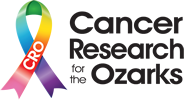Introduction to CRO
Cancer Research for the Ozarks (CRO) was founded in 1987 by a grant from the National Institute of Health, National Cancer Institute (NCI). In 2014, as the CCOP program ended CRO was selected to be one of only 34 community sites in the United States to participate in the NCI Community Oncology Research Program (NCORP). The overall goal of NCORP is to bring cancer clinical trials (cancer control, prevention, screening, treatment, and imaging), as well as cancer care delivery research (CCDR), to individuals in their own communities, thus generating a broadly applicable evidence base that contributes to improved patient outcomes and addresses health disparities and improves access to cancer care for underserved populations. NCI has been collaborating with community investigators and bringing research to communities for more than 30 years. NCORP builds on NCI’s previous community programs, maintaining the strong history of clinical research accountability, resource sharing and exchange, and partnership building between NCI, academic institutions, and communities. CRO was established as a cooperative venture of CoxHealth and Mercy and remains such today.
Two Joplin, MO components, Freeman Health System and Mercy Joplin have been affiliated with CRO since 1997 and are located 70 miles west of Springfield on the border of Kansas and Oklahoma. In 2010, Cox Medical Center in Branson located 45 miles south of Springfield and Central Care Cancer Center in Bolivar located 30 miles north of Springfield affiliated with CRO. The following year, Phelps County Regional Medical Center in Rolla, MO, 110 miles northeast of Springfield joined CRO. On June 1, 2013, Mercy Hospital, St. Louis, St. Louis Cancer and Breast Institute and Good Samaritan Medical Center in Mt. Vernon, Illinois became CRO components.
CRO’s total catchment area now covers 33 primary service counties and 33 secondary service counties totaling 66 counties in Missouri, Oklahoma, Arkansas, Kansas and Illinois. The primary and secondary service areas create a contiguous service area from Kansas, Oklahoma, and Arkansas across Missouri to Illinois. According to the US Census population estimates for 2012, CRO’s catchment area has a population of 4,174,908 (2,888,331 primary and 1,286,577 secondary).
Embracing their sponsors CRO’s mission statement is as follows:
Cancer Research for the Ozarks has a mission rooted in the spirit of collaboration between the Health Systems of Cox and Mercy in Springfield, Missouri. Inspired by our faith-based call to serve others, we seek to promote the quality of life within the communities we serve by providing innovative cancer research, education, and personal, compassionate presence with our patients, family members and staff.
Patients may participate in clinical trials from the following research groups through Cancer Research for the Ozarks.
They are:
Alliance for Clinical Trials in Oncology
NRG National Surgical Adjuvant Breast and Bowel Project (NSABP), the Radiation Therapy Oncology Group (RTOG), and the Gynecologic Oncology Group (GOG)
ECOG-ACRIN Eastern Cooperative Oncology Group (ECOG) and the American College of Radiology Imaging Network (ACRIN) SWOG
Southwest Oncology Group
